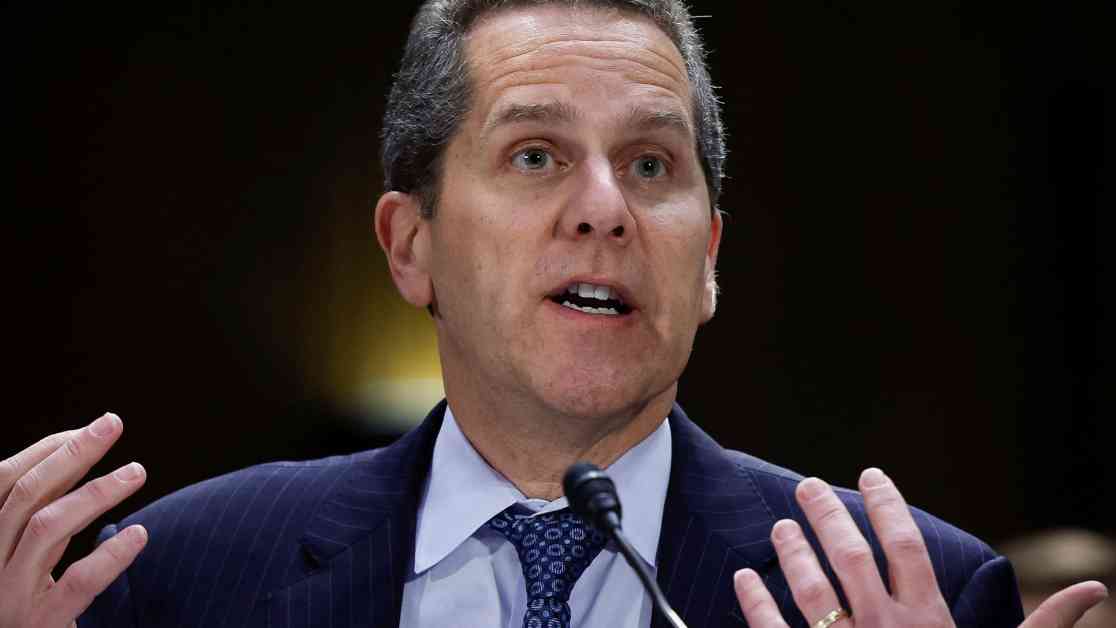Federal Reserve eases banking regulations, benefitting Wall Street
In a significant move that has Wall Street buzzing, the Federal Reserve Board Vice Chair for Supervision, Michael S. Barr, recently testified at a Senate Banking, Housing and Urban Affairs Committee hearing on “Recent Bank Failures and the Federal Regulatory Response.” The hearing, held on Capitol Hill in Washington on March 28, 2023, unveiled changes to proposed U.S. banking regulations that could have a profound impact on the financial industry.
The proposed regulatory overhaul, known as the Basel Endgame, was initially introduced in July 2023 with the intention of boosting capital requirements for the world’s largest banks by approximately 19%. However, in a surprising turn of events, officials at the Federal Reserve, the Office of the Comptroller of the Currency, and the Federal Deposit Insurance Corp. have agreed to resubmit the proposal with a more modest 9% increase in capital for big banks. This decision marks a significant departure from the original plan and suggests a more lenient approach to regulating the banking sector.
Fed Vice Chair Michael Barr emphasized the need for a balanced approach to capital requirements, stating, “There are benefits and costs to increasing capital requirements. The changes we intend to make will bring these two important objectives into better balance.” This shift in policy reflects a careful consideration of the potential consequences of imposing stricter regulations on financial institutions.
The initial proposal, which was a response to the 2008 global financial crisis, aimed to enhance safety and tighten oversight of risky banking activities such as lending and trading. By increasing the capital that banks are required to hold as a buffer against potential losses, the plan could have inadvertently made loans more expensive or harder to obtain, potentially driving some activities to non-bank providers. Industry trade organizations raised concerns about the impact of these regulations on the overall functioning of the financial system.
Notably, industry executives, including JPMorgan Chase CEO Jamie Dimon, were vocal opponents of the original proposal and actively lobbied against its implementation. Their efforts seem to have paid off, as the revised plan represents a significant concession to the banking industry. The decision to reduce the capital increase for large banks indicates a willingness on the part of regulators to listen to industry feedback and adjust their approach accordingly.
While the focus has primarily been on the implications for large banks, it is essential to consider how these regulatory changes will affect regional banks as well. Under the latest proposal, regional banks with assets ranging from $100 billion to $250 billion are excluded, with the exception of a requirement to recognize unrealized gains and losses on securities in their regulatory capital. This adjustment is expected to raise capital requirements for these banks by an estimated 3% to 4% over time, providing them with a more stable financial footing.
The decision to exclude regional banks from the increased capital requirements appears to be a response to the bank failures that occurred last year among mid-sized institutions. These failures were attributed to deposit runs triggered by concerns over unrealized losses on bonds and loans, highlighting the need for a more nuanced approach to regulating the banking sector. By tailoring the regulations to address specific vulnerabilities within the industry, regulators hope to prevent similar crises from occurring in the future.
As the story continues to develop, it is clear that the implications of these regulatory changes will reverberate throughout the financial industry. The decision to ease banking regulations, particularly for large banks, has sparked a debate about the balance between safety and profitability in the banking sector. While some argue that the revised plan will help stimulate economic growth by making credit more accessible, others caution against loosening regulations in a volatile market environment.
Impact on Wall Street
One of the key beneficiaries of the Federal Reserve’s decision to ease banking regulations is Wall Street. The reduced capital requirements for large banks are expected to have a positive impact on the financial sector, with implications for investors, shareholders, and the broader economy.
The move to lower the capital increase for big banks is likely to be welcomed by investors, as it could lead to higher returns on equity and increased profitability for these institutions. With less stringent regulations in place, banks may have more flexibility to engage in riskier activities that have the potential to yield higher profits. This could translate into higher stock prices and dividends for shareholders, making these banks more attractive investments for Wall Street firms.
Moreover, the decision to relax regulations on large banks could have a ripple effect on the broader economy. By making credit more readily available and reducing the cost of borrowing, the revised plan could stimulate economic growth and encourage investment in various sectors. This, in turn, could lead to job creation, increased consumer spending, and overall prosperity for businesses and individuals alike.
However, critics of the Federal Reserve’s decision warn that easing banking regulations could also pose risks to the financial system. By allowing banks to operate with lower capital buffers, there is a heightened risk of financial instability in the event of another economic downturn or crisis. This could potentially expose taxpayers to the burden of bailing out failing banks, as was the case during the 2008 financial crisis.
Challenges and Opportunities
The Federal Reserve’s decision to ease banking regulations presents both challenges and opportunities for the financial industry. While the reduced capital requirements may provide banks with greater flexibility and profitability, they also raise concerns about the potential for increased risk-taking and financial instability.
One of the key challenges facing regulators is striking the right balance between safety and profitability in the banking sector. By lowering capital requirements for large banks, regulators are essentially allowing these institutions to take on more risk in pursuit of higher returns. While this may benefit shareholders and investors in the short term, it could also expose the financial system to greater vulnerabilities in the long run.
At the same time, the decision to exclude regional banks from the increased capital requirements presents an opportunity for these institutions to strengthen their financial positions and better weather economic uncertainties. By recognizing unrealized gains and losses on securities in their regulatory capital, regional banks can enhance their risk management practices and improve their overall stability.
Regulators must remain vigilant in monitoring the impact of these regulatory changes on the financial industry and be prepared to adjust their approach as needed. The evolving nature of the banking sector and the complex interplay of economic factors require a proactive and adaptive regulatory framework that can effectively mitigate risks and safeguard the stability of the financial system.
As the story continues to unfold, it will be crucial for industry stakeholders, policymakers, and regulators to closely examine the implications of the Federal Reserve’s decision and work together to ensure a balanced and sustainable approach to banking regulation. Only by striking the right balance between safety and profitability can the financial industry thrive and contribute to the broader economic growth and stability.

















